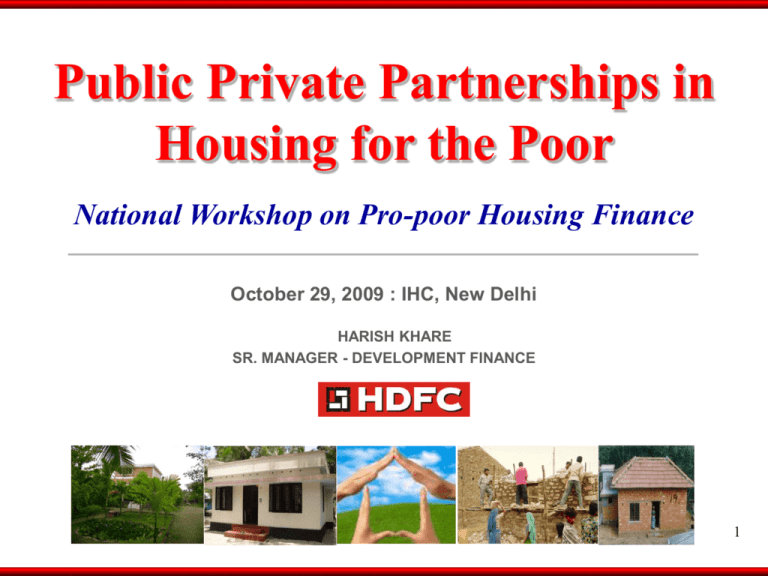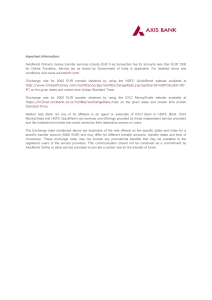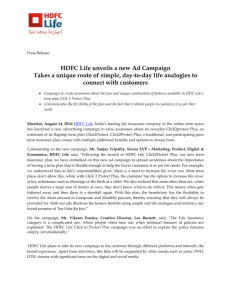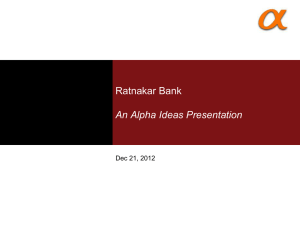10.Public Private Pa..> - NHB
advertisement

Public Private Partnerships in Housing for the Poor National Workshop on Pro-poor Housing Finance October 29, 2009 : IHC, New Delhi HARISH KHARE SR. MANAGER - DEVELOPMENT FINANCE 1 AGENDA • Why have PPPs – Relevance to Housing • PPP in Low-income / Affordable Housing • PPP in Low-income Housing Finance • Government’s role in encouraging PPP • Opportunities and Challenges • HDFC Snapshot 2 Why do PPPs Make Sense? Public Private Partnerships let Public Sector and Business do what they do Best! • Private Sector – Innovation, Use of Technology – Professional Management – Quality Assurance – Efficiency and Speed – Maintenance Practices – Financing linked to Viability – Sustainability and Scalability • Public Sector – Policy Setting – National Planning – Regulation and Governance – Looking after Public Interest – Facilitating Economic Growth and Development 3 Affordable Housing: Relevance of PPPs • PPP is emerging as an efficient model for delivery of services across sectors. • A recent study conducted by Knight Frank / NAREDCO suggests that affordable housing presents a commercial opportunity worth Rs. 5 lac crore. • 11.8 m dwelling units have to be built by 2014 across 37 cities, 90% EWS / LIG • Financial resources available to government are scarce and need to be optimised. • PPP approach allows state agencies to overcome resource deficit, improve cost recovery and increase supply of houses based on demand. • The public sector owns, controls and regulates the use of land which is the most valuable resource for any housing project. • Land, Incentive FSI, TDR, JNNURM grant and Budgetary resources are all elements controlled by govt. authorities and used judiciously for maximising the contribution of the private developer under the PPP framework. • Lower margins are compensated by huge volumes to derive profits. 4 AGENDA • Why have PPPs – Relevance in Housing • PPP in Low-income / Affordable Housing • PPP in Low-income Housing Finance • Government’s role in encouraging PPP • Opportunities and Challenges • HDFC Snapshot 5 E.g.’s of PPP in Affordable Housing • Bengal Ambuja Housing Development Ltd. • – A JV between Gujarat Ambuja Cements Ltd. and West Bengal Housing Board – Township development in Kolkata suburbs, Asansol Durgapur and Bardhaman – Houses priced at Rs. 2.5 lac to Rs. 6 lac for the benefit of LIG and MIG Dharavi Slum Redevelopment, Mumbai – Asia’s biggest in-situ slum rehabilitation scheme – Private developer undertakes the scheme with incentives from SRA / BMC • SEWA’s Parivartan Project, Ahmedabad – Provision of basic infrastructure and linkages in Ahmedabad slums – Tripartite arrangement involving SEWA Bank, Community and AMC • JNNURM funded slum redevelopment schemes across India – E.g. Pimpri Chinchwad, Nagpur, DDA Tehkhand etc. • New Town, Rajarhat, Kolkata: – Shapporji Pallonji and West Bengal Housing Infrastructure Devt. Corp. Ltd. 6 Illustration of a PPP model - Rajasthan • • • • • New Housing Policy of the Govt. of Rajasthan promotes PPP 75,000 houses (60% of budgeted target) for EWS / LIG through PPP Locations: Global city, Neemrana, Greater Bhiwadi and New Jaipur (1) Private Developer on Private Land: – Developer constructs G+3 EWS / LIG flats on 25-40% land owned by him – The se flats handed over to Govt. at pre-determined price of Rs. 750 per sq. ft. – Developer gets additional FAR, twice the permissible limit on entire plot – Additional FAR can be utilised on remaining plot area or exchanged for TDR – Waiver of EDC, Plan approval fees, Conversion charges; lower stamp uty (2) Private Developer on Govt. Land / Acquired Land – 50% of the land earmarked for construction of EWS / LIG flats – Bids invited, Developer offering maximum no. of (free) EWS / LIG flats selected – Developer free to construct and sell MIG / HIG flats on remaining 50% land • (3) Slum Redevelopment with participation of Private Developer 7 Slum Rehab. in Mumbai under PPP f/w • 60% of Mumbai’s population lives in slums • Slum Rehabilitation Authority was established in 1990 • • • – Slum lands treated as a resource offered by SRA / MCGM / MMRDA – Developer provides free homes to ‘eligible’ slum dwellers – A slum structure existing before 1995 is eligible for redevelopment; tenement size: 269 sq ft – Developers need approval of 70% of slum dwellers and submits the proposal to the Slum Rehabilitation Authority – Either in-situ development or slums are relocated if land is required for infrastructure purposes – Incentive FSI and TDRs given to developer, slum resettled, balance land developed and sold commercially – Profits from open market sale cross subsidises free housing Over 400 slum rehabilitation schemes in progress in Mumbai Slum resettlement initiatives need community involvement Commercial viability of SRS projects varies between slums at prime 8 locations to those that are in “difficult areas”. Funding of Slum Upgrading Projects • HDFC has financed rehabilitation housing, Infrastructure and basic services for slum communities and pavement dwellers through urban NGOs and CBOs. • Construction Finance / Project Finance amounting to over Rs. 300 crore disbursed for SRA schemes being implemented by private developers in Mumbai • Project financing of EWS / LIG housing projects (e.g. VAMBAY schemes) of urban development authorities and municipal corporations. • Mixed experiences and concerns regarding scaling up. 9 AGENDA • Why have PPPs – Relevance in Housing • PPP in Low-income / Affordable Housing • PPP in Low-income Housing Finance • Government’s role in encouraging PPP • Opportunities and Challenges • HDFC Snapshot 10 Scope for PPP in Housing Finance PUBLIC - PRIVATE PARTNERSHIP as against: • PUBLIC – PUBLIC PARTNERSHIPS – GOI’s Housing Subsidies through Urban Bodies / Dist.Auth. / Panchayats – HUDCO’s Loan Schemes for EWS / LIG (e.g. VAMBAY) – NHB’s Refinance to PSU Banks / RRBs (GJRHFS, Rural Housing Fund) – NABARD’s Refinance to RRBs, Co-operative Banks • PRIVATE – PRIVATE PARTNERSHIPS – HFCs / Pvt. Sector Banks Lending to MFIs / NGOs / CBOs – Housing Microfinance Product of Leading MFIs (SKS, UJJIVAN, BASIX) – HFCs offering low-income housing finance (e.g. MHFC, GRUH, DHFL) 11 Public v/s Pvt. – Anomalies in HF Traditionally the scope for PPP has been restricted to: • Channeling funds from Apex Banks / FIs in public domain to Credit Intermediaries in Private domain i.e. NGOs / MFIs etc. • The funding mechanisms deployed under public-public initiatives are not market based and hence may not be sustainable in long term. • Conflicts between Public - Public approaches vis-à-vis Private - Private approaches: Market linked v/s Subsidy oriented. This may create disparities at the ground level leading to delinquencies. • Outreach and quantum through Govt. / Public sector interventions far exceeds the presence of formal private sector financing. • However, given the huge shortage in housing stock, multiple and diverse approaches from different stakeholders need to be encouraged. • Worth exploring Govt. as a facilitator by leveraging subsidies with private capital to increase outreach and supply. 12 GOI Initiatives in Rural EWS Housing – Majority government initiatives have been targeted at very low income / below poverty line • Indira Awas Yojana (IAY) is a subsidy based program targeted at BPL households for new unit construction, subsidy being Rs. 35,000/- (over 15M units financed since 1985–1986) • Varied State based housing schemes initiated to augment central government schemes – Gujarat under Sardar Awas Yojana has increased outlay per housing unit under the IAY to Rs. 40,000 – Andhra Pradesh and Karnataka have independent housing schemes targeted at specific rural communities – Additional funds for such schemes are drawn as loans from HUDCO; typically low recovery rates – NHB administered Golden Jubilee Rural Housing Scheme provides refinance to banks / HFCs – NABARD’s refinance scheme under ‘Non-Farm Sector’ for Banks, Co-op. Banks, RRBs, ADFCs – => Refinancing schemes of NHB & NABARD have the following eligibility criteria: NABARD’s Refinance NHB’s Refinance (GJRHFS) Type of PLI Net NPAs (ceiling) Type of PLI Net NPAs (ceiling) SCBs 5% HFCs 5% RRBs 8% RRBs 7.5% Coop. Banks 10% SCBs & Coop. Banks 10% – Scheduled Commercial Banks lending for rural housing is approx. 10% of total mortgage lending Sl. No. 1 2 3 4* 5* Particulars Total housing loans outstanding Rural housing loans outstanding % of rural housing loans to total No. of dwelling units (rural) Loan Amount disbursed (rural) Source: NHB, Media Reports, World Bank Report 2002 32,826 3,160 9.6% 1,87,268 3,246 (Rs. in crore) 2003 2004 2005 46,470 85,346 1,26797 5,387 7,712 13,024 11.6% 9.0% 10.3% 1,78,200 2,43,753 2,58,562 3,816 6,354 6,441 2006 1,82,167 18,213 10.0% 2,98,651 8,368 13 HDFC’s Tie-up with KfW / GOI for Rural Housing Micro-finance • In the early eighties HDFC had a limited focus on low-income and informal sector households. • Attempts were made to finance weaker-section housing projects on an experimental basis across regions. • HDFC launched a new product: Home Savings Plan (1988). • In 1989, HDFC accessed low-cost loan funds from KfW, Germany with a focus on EWS housing. KfW emphasised on ‘financial sector intervention’ more than housing promotion. • GOI provided sovereign guarantee to KfW under bilateral co-op. • HDFC has assisted over 1.05 lac EWS households under 200 schemes by disbursing loan funds of Rs. 150 crore. 14 Lending Methodology: Intermediation By MFI / NGO HDFC --- Intermediary Agency --- CBO/ Federation/ SHG --- End Borrower The NGO-intermediary identifies the borrowing households with genuine need, checks on their socio-economic profile and furnishes relevant project information Prepares plans for the construction activity with the participation of borrowers and offers appropriate technical assistance during construction based on internal capabilities Concludes loan documentation with HDFC, outlines specific project parameters The loan disbursement from HDFC is split into smaller amounts and on-lent to the individual borrowers based on stage-wise progress of construction 15 Role Of The NGO / MFI... The owner is made fully responsible with the loan funds – to purchase building materials, use technology of his choice, and to hire masons and other skilled and unskilled workers Generally, construction is carried out without the engagement of private contractors. Technical guidance is made available through local building centers wherever possible. Ensures a minimum self-help contribution from the borrowers as equity into the housing process, by way of labour, cash, use of salvaged building materials etc. Monitors the construction work regularly – HDFC carries out a technical review by way of field visits prior to each disbursement. Facilitates the repayment of loan from the individual borrowers and makes a consolidated payment to HDFC; provides HDFC with progress and loan recovery reports. 16 Typical Loan Terms Gross household income of the borrower < Rs. 4000/- p.m. – or as per EWS definition Cost per dwelling unit < Rs. 90,000 Size of the house < 400 sq. ft. Loan amount not to exceed Rs. 100,000; or 90% of the cost of the house, whichever is lower Repayment term: Up to 15 years Rate of Interest: Fixed or Linked to HDFC’s RPLR Security: Equitable mortgage of dwelling units financed and any other security as acceptable 17 AGENDA • Why have PPPs – Relevance in Housing • PPP in Low-income / Affordable Housing • PPP in Low-income Housing Finance • Government’s role in encouraging PPP • Opportunities and Challenges • HDFC Snapshot 18 Land Policy for Affordable Housing • Simplifying processes for land acquisition, Reviewing processes of master planning and treat affordable housing as a ‘public purpose’ • Land related issues i.e. bringing in additional lands, allowing higher FSI / FAR and in-situ development of slums, all need to be implemented in an integrated manner • Formal recognition of ‘security of tenure’ by the Government. Several forms of providing security can be explored – Ensure that there is no threat of eviction – Tenurial security to facilitate access to market funds • Improve the speed of transactions through cadastrals, computerised land records and application of e-governance to land transactions • Need to foster an environment that will make rental housing for EWS/LIG categories a worthwhile investment • Set up a Regulator for real estate which has a mandate for affordable 19 housing, enact model laws in states Fiscal and Financial Framework Funding of Affordable Housing through: – – – – Allocation of additional budgetary resources (JNNURM) Creation of a pool of resources called ‘Shelter Fund’ (0.5% cess on taxes) Incentivise HFCs and Banks to encourage investment flows Allow HFIs to access long-term External Commercial Borrowings (ECB) Role of State Housing Boards (SHBs) – The role of SHBs needs to be revamped – Focus on playing a more active role in the provision of affordable housing through Public Private Partnerships – Funds raised through sale of land transactions by SHBs must be ring fenced, with a defined proportion to be deployed for affordable housing 20 Fiscal and Financial Framework Tax Related Incentives • Tax incentives for developers and HFIs engaged in affordable housing • Reduction in stamp duty rates and registration fee for affordable housing to 2% ad valorem uniformly in all states. Levy a flat charge of Rs 1,000/- on registration of equitable mortgages. • Bring ‘affordable housing’ under the infrastructure definition. Financial Institutional Recommendations • Establish a national HFC focusing only on housing micro-finance. • Promote household savings: allow financial institutions lending to the poor employed in the informal sector to accept deposits: – Savings can enable a down payment for a loan. – Will enable the lender to assess the savings pattern of the customer. 21 AGENDA • Why have PPPs – Relevance in Housing • PPP in Low-income / Affordable Housing • PPP in Low-income Housing Finance • Government’s role in encouraging PPP • Opportunities and Challenges • HDFC Snapshot 22 Upcoming Projects in the Pvt. Sector • • • • • • • • • • • • Janadhar Construction Pvt. Ltd. – Attibele, Bangalore CSC Constructions at Attibele and Devanahalli, Bangalore Provident Housing – a subsidiary of Purvankara Projects Santosh Associates – Batwa near Ahmedabad Matheran Realty Co. – Tanaji Malasure City, Karjat, Mumbai Shapporji Pallonji – New Town Rajarhat, Kolkata Tata Housing – Nano Housing Project at Boisar, Mumbai Omaxe Ltd. Subsidiary – National Affordable Housing Co. DLF and UNITECH have announced their forays Micro Housing Finance Corporation, a new HFC at Mumbai Aarusha Homes – Dormitory / Hostel Acco. for workers in AP Emkay Group, Malaysia – likely to partner with Embassy 23 MFIs/NGOs in Housing Microfinance • • • • • • • • • • • • • • SEWA BANK and Mahila Housing Trust SKS Microfinance, Andhra Pradesh BASIX / BSFL (Individual Lending) RGVN (Individual Lending thru’ NGOs in NER) ASA (Grameen Model, Tamil Nadu) BWDA (SHG approach, Tamil Nadu) DHAN Foundation (SHG Federations, Southern India) FREED, GSGSK, WWA, KIDS (Kerala) SPARC, Slum Rehabilitation Society, Mumbai AVAS, a housing rights NGO at Bangalore Janalakshmi Social Services, Bangalore IASC, an HDFC promoted MFI UJJIVAN, an urban MFI at Bangalore MIMO Finance, Uttarakhand 24 Prospects and Challenges • • • • • • • • • Include low-income housing under Priority Sector lending (loan < 10 lac) Promote a credit bureau dedicated for micro-finance clientele. Facilitate security enforcement – recovery of EWS housing loans. Proposed introduction of a mortgage repository. Need to attract private capital and foreign direct investment. Access to long-term funding such as pension funds. Deepening the secondary mortgage market. Access to mortgage insurance. Need for a real estate regulator: – Consumer protection and transparency – Serve as a single window for overseeing affordable housing agenda – Promote real estate reforms • Increased investment in low-cost, eco-friendly construction technologies. 25 AGENDA • Why have PPPs – Relevance in Housing • PPP in Low-income / Affordable Housing • PPP in Low-income Housing Finance • Government’s role in encouraging PPP • Opportunities and Challenges • HDFC Snapshot 26 AN OVERVIEW OF HDFC • Incorporated in 1977 as the first specialised mortgage company in India • Objectives: – Enhance residential housing stock through the provision of housing finance on a systematic and professional basis and to promote home-ownership; – Increase the flow of resources for ‘housing’ through an integration of the housing finance sector with the overall domestic financial markets. • Now a Financial Conglomerate with interests beyond mortgages: HDFC 72.4% HDFC Standard Life • 60% HDFC Asset Management 22.7% HDFC Bank (inclusive of warrants) 74% HDFC ERGO General Insurance 100% HDFC Property Ventures 80.5% HDFC Venture Capital 90% of initial shareholding in the hands of domestic institutions and retail 27 investors and currently 75% shares held by Foreign Investors HDFC Snapshot MORTGAGE BUSINESS SUMMARY • Mortgage Loan Assets (As of March 2009) : : Rs 851.98 bn US$ 16.9 bn • Cumulative Loan Disbursements (Inception to March 2009) : : Rs 1918.06 b US$ 38 bn • Loan Disbursements : Rs 396.50 bn (FY March 2009) : US$ 7.9 bn • Cumulative Housing Units Financed : 3.3 million • Mortgage Loans CAGR (5 years) : 25% 28 HDFC Snapshot NATIONAL SPREAD No. of Outlets Regional office Branch office Outreach Programmes to 90 locations 1999 2000 2001 2002 2003 2004 2005 2006 2007 2008 2009 – – – – – – – – – – – 49 67 87 118 142 173 203* 219* 234* 250* 267* Deposit & loan products offered to individuals in over 2400 towns and cities. * Inclusive of 56 outlets of wholly owned distribution co. 29 BUSINESS MODEL & PERFORMANCE HDFC – The Business Model • Backing of visionaries • Adopted the philosophy of “learning by doing” • Strong corporate values and culture with emphasis on transparency, integrity and commitment • High service standards • Emphasis on training and technology • Low administrative costs • Empowering line managers HDFC – Performance Indicators (FY 2009) • Cost to income ratio: 8.8% (amongst lowest in financial services in Asia) • Non-performing loans: under 1% (Total loan write offs since inception are only 4 basis points of cumulative disbursements) • 99% of HDFC’s assets are Loans (89%) and Investments (10%) 30 DEVELOPMENT INITIATIVES • HDFC offers consultancy, technical services and residential training programmes dedicated to housing finance • Another method of outreach – helps spread our expertise • Participants from various countries – facilitates sharing of best practices • Trainers are staff members of HDFC • Focus on practical aspects of housing finance 31 Thank You 32







